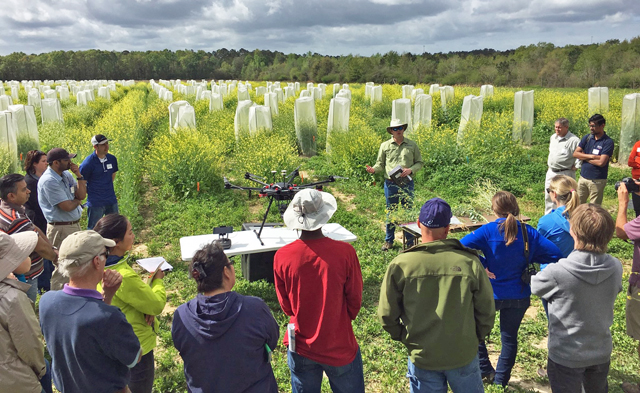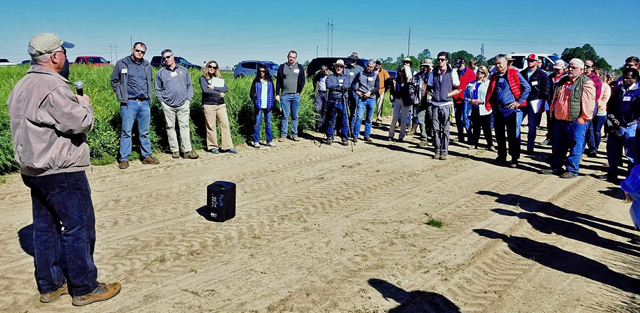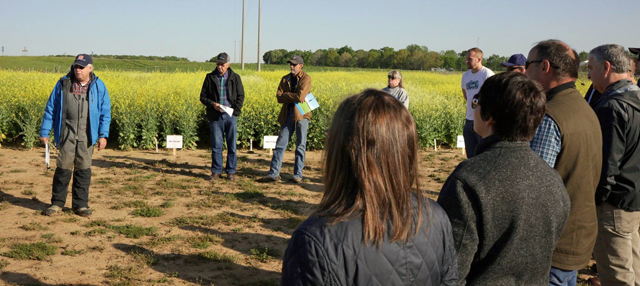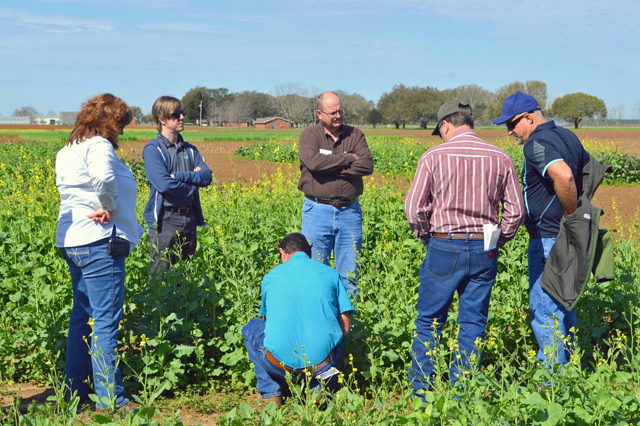
Ian Small, UF/IFAS Plant Pathologist, discussed disease management and advanced scouting tools at the Carinata Field Day in Quincy, FL.
Authors: Dan Geller, Ben Christ, Wendy-Lin Bartels, Bill Hubbard, Sheeja George, Ian Small, David Wright
This Spring, both farmers and researchers in the Southeast United States are at work. Inside the farm gate, producers are taking advantage of every opportunity to be out with their crops, putting in extra time to ensure their production goals for the season will be met. At the same time, researchers participating in the Southeastern Partnership for Advanced Renewables from Carinata (SPARC), a USDA NIFA CAP funded grant project, are putting in long hours in the field, greenhouses, and laboratories to develop new varieties of carinata, an emerging oilseed crop in the Southeastern US.
Carinata is grown in the cool-season to provide a second cash crop that can be used to produce high-grade jet fuel, diesel, gasoline and animal feed, as well as provide cover crop benefits. SPARC scientists are working on best management practices for production, and post-harvest uses of the seed to help producers by increasing yields and profitability of carinata. Maintaining the connection between scientists and producers is imperative. Early in its formation, SPARC leadership foresaw the need for a strong and diverse extension team that would serve as a bridge between scientists, producers, and regional extension agents.

David Wright, UF/IFAS Agronomist, discussed carinata production best management practices at the Carinata Field Day in Tifton, GA.
The SPARC team hosted carinata field days in Jay, and Quincy, Florida, Milstead, Alabama, and Tifton, Georgia this spring. The SPARC events in Jay, FL (February) and Quincy, FL (March) attracted over 50 interested farmers, extension agents, academics, and agency representatives who came to learn more about carinata production from SPARC experts and collaborators. SPARC members presented topics on carinata production including weed, pest, disease and fertility management. The team also discussed planting and harvesting techniques as well as timing of planting and harvest to fit into common crop rotations in the Southeast. An overview of carinata contracts and crop insurance was also provided to attendees of these events. The field days provided the opportunity to observe carinata in the field and discussion included details of SPARC experiments at each site.
Some of the key points addressed at the field days were:
- Carinata genotype multi-location trials are underway to evaluate advanced breeding lines under diverse environmental conditions. Crop improvement efforts continue to target enhanced cold tolerance, early maturity, high oil and seed yield in carinata
- Carinata’s “fit” as a winter cash crop in Southeast cropping systems was emphasized
- Best management practices for carinata production were discussed – timely planting is key (early to mid-November for North Florida). For more details on row spacing, nutrient management, pest management, harvest management, seed depth, tillage requirements refer to the production manual and other resources on www.sparc-org.org; www.growcarinata.com
- Crop insurance stipulations for carinata were discussed. For more details on production contracts and insurance contact a representative from Agrisoma www.growcarinata.com.
- The importance of a life cycle analysis (LCA) to understand the overall impact of carinata production in the southeast was presented. Ongoing research is focused on increasing value to stakeholders in the carinata supply chain – from seed supplier to producer, handler, processor, fuel and coproduct end-user

Austin Hagan, Auburn Plant Pathologist, discussed disease management and variety evaluations at the Alabama Carinata Field Day.
One of the team’s primary objectives is to understand the farmers’ expectations and what they would need to effectively grow the crop during the winter months. Dr. Wendy-Lin Bartels and Benjamin Christ, both from the University of Florida’s School of Forest Resources and Conservation, are social scientists leading SPARC’s understanding of the barriers and opportunities that may exist for producers in the Southeast to adopt carinata. They began with broad questions directed to the many stakeholders involved with SPARC and have since directed their focus to regional agents and producers. Through surveys at Carinata Field Days and phone interviews, Wendy-Lin and Ben have constructed a model of the barriers and opportunities relevant to producers in the Southeast. This information is directed back to SPARC and serves as the producers’ collective voice as researchers continue their work to develop better, regionally appropriate varieties of carinata.

Agrisoma representatives discussed production and marketing options at the Carinata Field Day in Jay, FL.
As carinata harvest approaches and field studies wind down for the year, the extension team will begin to work with SPARC researchers to develop tools to provide farmers the most up-to-date publications. The extension team has already started a working relationship with the feedstock team, which is expected to result in several critical publications to be published by extension in Florida, Alabama and Georgia. The team will soon begin work on the first of the SPARC e-Learning courses to be developed during the program which will utilize expertise from all the SPARC research teams to provide continuing education to extension agents, crop advisers, and other key stakeholders in the carinata supply chain.
- Managing Peanut Health and Diseases in the Winter - January 31, 2025
- Bridging the Gap: Empowering Youth with Ag-Tech Skills - July 16, 2024
- Time to Protect your Cotton from Premature Defoliation due to Foliar Diseases - July 30, 2021
